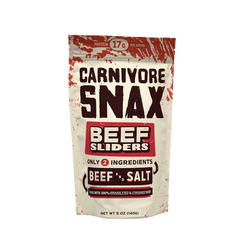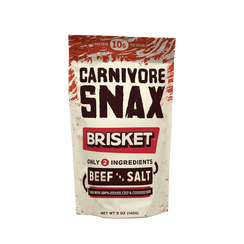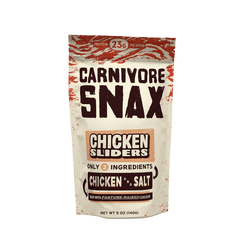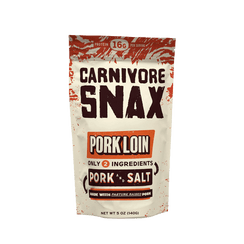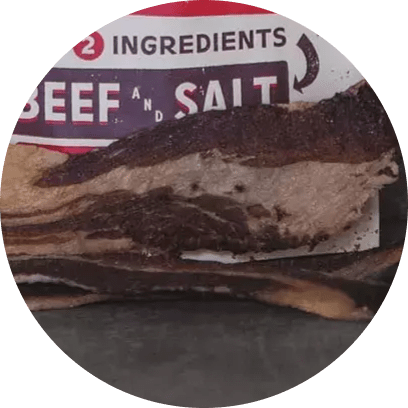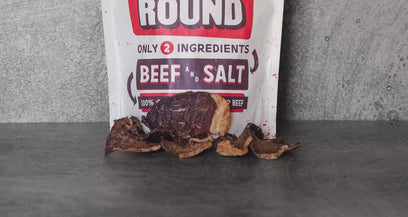THE CARNIVORE DIET BENEFITS




Your meals meal are than just a plate of food, but a statement of values. What you choose to put in your body shapes your health, the environment, and the socio-economic fabric of our communities.
Perhaps this realization is what brought you here today, as you consider the possibility of following a regenerative agriculture diet plan. Well, you’re in the right place.
Here at Carnivore Snax, our meat chips are sourced 100% from the most elite, ethical regenerative farms in the country. We’re passionate about this topic, and in this guide, we’re going to explain why we feel that everyone should eat food that’s been raised under regenerative principles.
You’ll discover the benefits not just for you, the consumer, but for our lands, the farmer who grows/raises your food, and everyone in between. Then, you’ll gain insights on how to go about sourcing your food to start your diet on the right foot.
First, let’s set the stage with a brief overview of what regenerative farming entails.
What is Regenerative Agriculture?
So, what is regenerative farming? We’ll provide a regenerative agriculture definition below and guide you through how this approach to farming differs from the conventional norm.
Regenerative Agriculture Defined
Regenerative agriculture is not just a buzzword; it's a holistic approach to farming and food production that aims not only to sustain, but to rejuvenate and enhance the health and vitality of the soil, the environment, and, consequently, the food we consume.
In stark contrast to conventional farming methods, which often deplete the soil and degrade ecosystems, regenerative practices nurture a vibrant and diverse ecosystem below ground, encouraging beneficial microbes, insects, and other organisms to flourish.
How it Works
The beauty of regenerative agriculture lies in its simplicity and its adherence to nature's rhythm. How does regenerative agriculture work, though? Here's a snapshot of the most common regenerative farming techniques:
- Soil Health: At the heart of regenerative farming is the understanding that healthy soil produces healthy plants. By avoiding the use of synthetic fertilizers and chemicals, the soil retains its natural balance of nutrients, fostering stronger, more resilient crops.
- Cover Cropping: Instead of leaving soil exposed, regenerative farmers use cover crops. These crops protect the soil, reduce erosion, and improve its structure and fertility.
- Crop Rotation and Diversity: By rotating crops and integrating livestock into crop production, farmers can break pest cycles, improve soil fertility, and reduce the need for chemical inputs. This leads to superior biodiversity - an important aspect of regenerative farming.
- Minimal Soil Disturbance: Tilling can disrupt the natural ecosystem of the soil. Regenerative practices often include no-till or reduced-till methods, ensuring the soil structure remains intact and carbon is sequestered.
- Natural Livestock Integration: Livestock, when managed well, can play a crucial role in regenerative farming. Their natural behaviors, from grazing to waste, can enhance soil health, leading to richer, more flavorful foods. We talk about this more in our guides to regenerative cattle farming and regenerative agriculture grazing.
- Agroforestry: Incorporating trees and shrubs into farming systems not only benefits the environment by providing habitats for wildlife and sequestering carbon but also offers shade and wind protection for crops.
There’s a lot that goes into starting and maintaining this farm, so why is regenerative agriculture important? Let’s get into some of the benefits of following a regenerative agriculture diet below, starting from the viewpoint of you - the consumer.
The Health Benefits of Following a Regenerative Agriculture Diet Plan
To fully grasp the benefits of regenerative farming, you must have an understanding of the shortcomings our current food supply chain exhibits. The truth is that commercial agriculture prioritizes profits and output over food quality or ethics.
This leads to questionable tactics like the use of synthetic fertilizers, pesticides, growth hormones, animal abuse, and more. The end result? Your health is potentially compromised as you eat residual remnants of chemicals. And, the path your food takes before getting to your plate is riddled with immorality for animals and problems for our lands.
Because regenerative farming takes a different approach, you don’t have to stress about this when following a regenerative agriculture diet plan. Here are three compelling reasons to make the switch:
Nutritional Superiority
Embracing a diet centered around foods produced through regenerative agriculture often means consuming produce and meats that boast a richer nutrient profile.
Healthy soils, brimming with organic matter and microbial life, typically yield crops with higher concentrations of vitamins, minerals, and antioxidants.
For instance, organically and regeneratively grown fruits and vegetables often have more vitamin C, iron, magnesium, and phosphorus than their conventionally grown counterparts.
Additionally, meats from animals raised on regenerative farms tend to have a more balanced omega-3 to omega-6 fatty acid ratio, making them not only delicious but also beneficial for heart health.
Avoiding Harmful Chemicals
One of the significant advantages of regenerative agriculture is the reduced dependence on synthetic fertilizers, pesticides, and herbicides. By following a regenerative agriculture diet, you significantly lower your exposure to these potentially harmful chemicals.
Many of these chemicals have been linked to a range of health issues, from hormone disruption to even more severe ailments.
When you choose regeneratively grown foods, you're not only investing in your health but also in a system that prioritizes the well-being of our lands. More on that later.
These Foods Tend to Taste Better, Too!
Beyond the clear health advantages, there's another delightful benefit to regeneratively produced foods: they often taste better. Many people attest to the richer flavors and textures of organically grown produce and pasture-raised meats.
The reason is straightforward: well-nurtured soil produces robust, healthy crops, and stress-free, naturally grazing animals yield higher-quality meats.
This quality transcends from the farm to your plate, offering a culinary experience that not only nourishes your body but also delights your taste buds. You’ll literally taste the difference.
This is especially true in our Carnivore Chips, which are melt-in-your-mouth delicious. We’ll introduce you to these later on, but let’s look at some of the other reasons to consider a regenerative agriculture diet.
The Benefits of Regenerative Farming Extend Beyond You, the Consumer, Too
As we mentioned before, regenerative farming isn’t just better for the consumer: the farmers themselves, the animals being raised, and our lands as a whole thrive.
Benefits For Our Lands
When we speak of regenerative agriculture, the term “regenerative” is pivotal. It's not just about sustaining: it's about reviving, rejuvenating, and replenishing.
Our planet's lands have, for decades, borne the brunt of intensive farming practices that strip the soil of its nutrients, leading to vast expanses of degraded land. Regenerative farming is the antidote to this.
Regenerative agriculture prioritizes soil health, recognizing it as the backbone of a thriving ecosystem. Techniques like regenerative agriculture fertilizer, crop rotation, cover cropping, and minimized tilling play crucial roles. The result?
Improved water retention, reduced soil erosion, and a significant decrease in the harmful runoff that can contaminate waterways. In essence, regenerative agriculture doesn't just halt land degradation - it actively reverses it, ensuring that our lands remain fertile and productive for future generations.
Ethical Treatment of Animals
Modern industrial farming often sees animals as mere commodities, leading to practices that prioritize efficiency over the well-being of the creatures in their care. In contrast, regenerative farming respects the intrinsic value of all life.
Animals on regenerative farms live more in line with their natural behaviors. Cattle graze on open pastures, chickens scratch at the soil and bask in the sun, and pigs wallow in mud, just as nature intended.
These animals aren't just given space - they're integrated into the farming system in a way that benefits both them and the land they inhabit. Such ethical treatment results in not only healthier animals but also higher-quality produce for the consumer.
Farmers Are Better Off, Too
Beyond the ethical and environmental benefits, regenerative agriculture also offers a ray of hope for the stewards of our lands: the farmers. In a world where many farmers find themselves at the mercy of fluctuating market prices and high input costs, regenerative practices offer a way out.
By relying less on expensive, synthetic inputs and by fostering soil that's naturally more fertile and resilient, farmers can reduce costs in the long run.
Additionally, the produce and meats from regenerative farms often command higher prices in the market due to their superior quality and the growing demand from informed consumers.
Financial stability, combined with the knowledge that they're contributing positively to the planet and its inhabitants, makes farming a more viable and fulfilling profession. Our guide on the profitability of regenerative farming is a great resource if you’d like to learn more.
We have a complete list of the regenerative agriculture pros and cons if you’d like to learn more, but we’ll spare you the trouble: the only cons are that it’s a bit harder to find food of this caliber!
As the rest of the world awakens and discovers the power of this approach to farming, hopefully, it will become more affordable and accessible.
In the meantime, here are some tips on how to about sourcing the food for your regenerative agriculture diet plan.
Tips for Sourcing Regenerative Agriculture Food
Convenience often takes precedence over quality in today’s fast-paced world. As such, finding foods that align with regenerative principles might seem like a daunting task.
Yet, with increasing awareness and demand, sourcing such foods for your regenerative agriculture diet plan is becoming easier than ever. Here's your guide to ensuring that your plate champions regenerative practices:
Where to Find Regeneratively Farmed Food Near You
While you may be able to find regeneratively grown/raised food at your local grocery store, it’s more likely you’ll have to adopt a new approach to shopping:
- Farmers’ Markets: One of the best ways to get your hands on regeneratively farmed foods is at local farmers’ markets. Here, you can directly engage with farmers, asking them about their practices and ensuring the food's authenticity. Plus, there's the added bonus of supporting local businesses and reducing your carbon footprint.
- Local CSA Programs: Community Supported Agriculture (CSA) programs allow individuals to subscribe to the harvest of a certain farm or group of farms. It's like having a direct line to the freshest, most ethically grown produce in your area. Plus, these programs often provide unique produce varieties that might not be available in mainstream stores.
- Specialty Grocery Stores: As regenerative agriculture gains momentum, many specialty grocery stores and health food outlets are beginning to stock products from regenerative sources. Look out for labels or ask store attendants for more information.
Supporting the Right Brands Online
You can also find regeneratively grown snacks and foods online with brands that source their products from regenerative farms. That being said, finding genuine regenerative agriculture brands can be a bit of a challenge.
With so many labels and claims thrown around, how can you ensure that you're truly supporting a brand that walks the talk? Here are some guiding principles, along with a recommendation we hold close to our heart:
- Research the Brand’s Story: True regenerative agriculture brands are proud of their journey and are transparent about their practices. Dive deep into the 'About Us' sections, read their blogs, and understand their mission.
- Check Certifications and Partnerships: Often, brands aligned with regenerative agriculture will be associated with specific certifications or organizations that champion sustainable farming. These affiliations can be a stamp of credibility.
- Customer Reviews: Never underestimate the power of community. Authentic brands will have a loyal customer base that vouches for their practices, not just the quality of their products.
As we mentioned at the start, we put our money where our mouth is - sourcing our Carnivore Chips from the most elite, ethical regenerative farms in the nation.
Wait, what are meat snacks, though? These have been referred to as “meat pastries” because they literally melt in your mouth, giving way to tantalizing flavors in every bite.
They’re just 2 ingredients - meat and salt. So, they’re not just delicious - they’re a great addition to any regenerative agriculture diet. From keto to carnivore, paleo, or even if you’re just an athlete trying to increase protein intake, these are a must-try.
We have a range of cuts to choose from too so you’ll never get bored: ribeye chips to steak chips, lamb chips, beef chips, brisket chips, chicken chips, or pork chips. Take a look and see which you want to try first.
There’s one more way to go about starting your regenerative agriculture diet plan, though: learning how to do regenerative agriculture yourself!
Growing Your Own Food
If you're keen on a hands-on approach, why not start your mini regenerative farm? It doesn’t just help you get better food - it’s an unbelievably fulfilling experience. Here are some ways to get started:
- Backyard Gardening: Even with limited space, you can adopt regenerative practices. Compost kitchen waste, practice crop rotation, and avoid synthetic chemicals. Over time, you'll notice richer soil and more vibrant plants.
- Community Gardens: Joining or starting a community garden can be a great way to expand your efforts and learn from others. It's also an excellent way to spread awareness about regenerative agriculture within your community.
- Workshops & Courses: Equip yourself with knowledge. Many local organizations and online platforms offer courses on regenerative agriculture and gardening practices.
Taking the initiative to source or grow regeneratively farmed food not only benefits your health but is also a vote of confidence in a system that uplifts our environment, animals, and farmers.
Every bite is a step towards a more sustainable and harmonious world. With that being said, there are a few more tips on how to support regenerative agriculture beyond what you eat in our blog post. For now, though, let’s bring this conversation to a close so you can start your new diet!
Parting Thoughts on Regenerative Agriculture Diet Plans
As we conclude our exploration into the regenerative agriculture diet, it becomes clear that this isn't merely a diet - it's a commitment to better health, not just for us, but for our lands.
Every meal we consume carries a story, a journey from the soil to our plates. By choosing regeneratively grown foods, we're advocating for a story that speaks of rejuvenated lands, ethical treatment of animals, and empowered farmers.
But embarking on this dietary journey is not just about sustainability, but also about indulging in superior nutrition, savoring tastier meals, and supporting the global shift towards a brighter, more sustainable future.
Remember, every bite counts. With resources like our Carnivore Chips, sourced exclusively from regenerative farms, integrating this diet into your lifestyle becomes not just feasible but enjoyable.
Get the best meat snacks today and jumpstart your regenerative agriculture diet plan!











